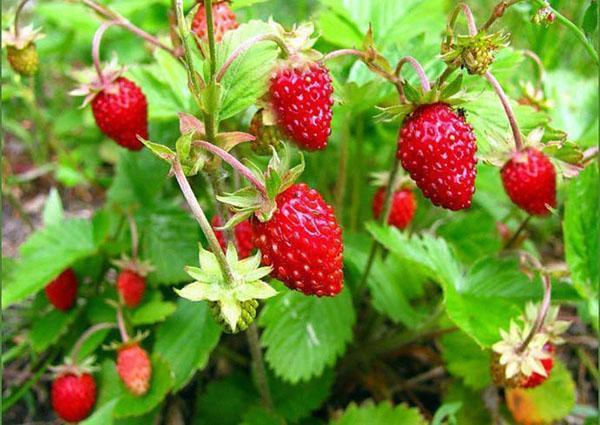Perhaps in your garden there is a place for strawberries of the Alexandrina variety.
 Fragrant, beautiful and tasty Alexandrina strawberries are suitable for growing in the garden and flower beds. This useful fruit crop has high decorative qualities, therefore it is often used for vertical or horizontal gardening. But its main purpose is to give a rich harvest of berries all summer long.
Fragrant, beautiful and tasty Alexandrina strawberries are suitable for growing in the garden and flower beds. This useful fruit crop has high decorative qualities, therefore it is often used for vertical or horizontal gardening. But its main purpose is to give a rich harvest of berries all summer long.
Variety characteristics

The repairing mustacheless strawberry Alexandrina forms compact bushes up to 25 cm high with large leaves. Therefore, when planting seedlings in open ground, the distance between the plants is maintained at least 20 cm.
The plant blooms in the first year after planting in mid-May. Fruiting begins in June and continues until October, while the outside temperature is above zero. The fruits are oblong, bright scarlet and sweet and sour taste. Tasting score - 4 points. The first harvest has the largest fruits. The berry mass reaches 8 g. Fruits keep on the bushes for a long time even after full ripening, darken and acquire even greater sweetness. Berries contain a lot of vitamin C.
Description of the strawberry variety Alexandrina:
- resistant to frost;
- drought resistance is average;
- has strong immunity against pests and bacteria;
- exposed to fungal diseases, especially in rainy summers.
In general, the variety is unpretentious, adapted to a changeable climate and daily sharp changes in temperature. To minimize the likelihood of plant damage by fungal diseases, follow the planting scheme and provide good ventilation beds.
Growing from seeds
 Good planting material gives rich yields for 2-3 years in a row. To get it, you need to properly prepare the seeds and provide them with good conditions for germination.
Good planting material gives rich yields for 2-3 years in a row. To get it, you need to properly prepare the seeds and provide them with good conditions for germination.
The strawberry Alexandrina does not give a mustache, which means that only seeds multiply.
They retain a high percentage of germination for 5 years, but for friendly seedlings it is better to take material that is no more than 2 years old.
Stages of growing from strawberry seeds Alexandrina:
- soaking seeds in warm water for 2 days;
- stratification 2 weeks;
- picking seedlings;
- landing in open ground in May.
Strawberry cultivation starts in February. Collect the snow, let it melt and soak the required amount of seeds in melt water for 2 days in room conditions. A shallow container is filled with a mixture of sand, peat and turf. Snow is placed on top and pre-soaked seeds are scattered over the snow. The container is covered with polyethylene and placed in a refrigerator for stratification. After 2 weeks, the container is taken out, placed in a warm, consecrated place and the soil is moistened as it dries.
Seedlings will appear in 2-3 weeks. Seedlings are kept away from the bright sun until they get stronger. After the appearance of 2-3 leaves, Alexandrina strawberries dive into separate containers. The soil is nourishing, breathable.
Strawberries grow very slowly, so activities for their cultivation begin in the midst of winter.
By the month of May, when the threat of return frosts has passed, small sockets, along with a lump of earth, are transplanted into prepared holes in the beds. The distance between the plants is maintained at 20-30 cm, the distance between the rows is 30-40 cm. The ground around the bushes can be mulched with straw or sawdust.
Care
 After rooting in the open field to stimulate the growth of the bush, Alexandrina strawberries are fed nitrogen fertilizers... This is an infusion of mullein or specially designed store preparations with a high proportion of nitrogen.
After rooting in the open field to stimulate the growth of the bush, Alexandrina strawberries are fed nitrogen fertilizers... This is an infusion of mullein or specially designed store preparations with a high proportion of nitrogen.
Taking care of the plant is simple. You do not need to remove the mustache, you do not need to pollinate the plant either, its flowers are bisexual. Grooming activities are reduced to watering during the dry period and in feeding 3-4 times per season.
The second feeding is carried out during the budding period with phosphorus-potassium fertilizers. The third - during the second wave of flowering and fruiting in the month of July.
By the end of summer, feeding is stopped to allow the plant to prepare for winter. In October, the aboveground part is cut off and the soil is mulched with a new layer of straw or sawdust. No special covering material is used to protect the plant from frost. Strawberries hibernate well without shelter.
Alexandrina is a proven garden strawberry variety suitable for growing in temperate climates. High taste and ease of care makes this plant one of the most popular in amateur summer cottages.